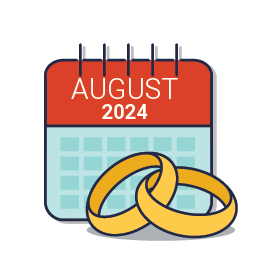Your feedback can help us improve and enhance our services to the public. Tell us what matters to you in our online Customer Satisfaction Survey.
In 2024 there were 668 same-sex marriages, 325 male and 343 female.
There were 19,680 opposite-sex marriages in 2024. The average age of grooms remains unchanged at 37.7 years since 2023. The average age of grooms rose from 26.9 years in 1974 to 27.3 years in 1984 and increased to 37.7 years in 2024. There is a similar trend for the average age of brides, increasing from 24.6 years in 1974 to 25.2 years in 1984 before rising to 35.9 years in 2024.
There were 20,348 marriages (opposite and same-sex) in 2024 compared with 21,159 in 2023, a decrease of 811 (3.8%). There were 3.8 marriages per 1,000 population in 2024, down from 4.0 in 2023. Around three in every 100 marriages (3.3%) were same-sex in 2024.
| Number of Marriages, 2022-20241 | |||
| 2022 | 2023 | 2024 | |
| Opposite sex | 22,555 | 20,513 | 19,680 |
| Same Sex | 618 | 646 | 668 |
| All marriages | 23,173 | 21,159 | 20,348 |
| All Marriages rate per 1,000 population | 4.5 | 4.0 | 3.8 |
| Average Age of Groom (Opposite-Sex Marriage) | 37.4 | 37.7 | 37.7 |
| Average Age of Bride (Opposite-Sex Marriage) | 35.4 | 35.8 | 35.9 |
| Average Age of Male (Same-Sex Marriage) | 39.4 | 40.8 | 40.7 |
| Average Age of Female (Same-Sex Marriage) | 38.2 | 38.0 | 39.7 |
| 1 Rates revised for 2022 and 2023 due to updated Population of Census data. | |||
| X-axis label | All Marriages | Opposite-Sex Marriages | Same-Sex Marriages |
|---|---|---|---|
| 2020 | 9523 | 9209 | 314 |
| 2021 | 17217 | 16717 | 500 |
| 2022 | 23173 | 22555 | 618 |
| 2023 | 21159 | 20513 | 646 |
| 2024 | 20348 | 19680 | 668 |
In 2024, religious ceremonies accounted for 59.5% of all marriages. There were 6,425 (31.6%) Catholic marriage ceremonies, 193 (0.9%) Church of Ireland ceremonies, The Spiritualist Union of Ireland performed 1,446 (7.1%) ceremonies and 4,034 (19.8%) couples opted for other religious ceremonies. The majority of non-religious ceremonies were civil marriages which accounted for 33.1% (6743) of all marriages; the remaining 1,507 (7.4%) couples had Humanist ceremonies. See Table 1 and Figure 2.
| % | |
| Roman Catholic | 31.5755848240613 |
| Civil Marriages | 33.1383919795557 |
| Humanist Association | 7.40613328091213 |
| Spiritualist Union of Ireland | 7.10634951838019 |
| Other Religious | 19.8250442303912 |
| Church of Ireland | 0.94849616669943 |

60.2% of all opposite-sex marriages were religious ceremonies in 2024. There were 6,425 (32.6%) Catholic services, 1,374 (7.0%) by the Spiritualist Union, 193 (1.0%) in Church of Ireland ceremonies, and 43 (0.2%) Presbyterian services. A further 3,814 (19.2%) ceremonies were held under other religious denominations. Civil marriages accounted for 6,392 (32.5%) while the remaining 1,439 (7.3%) were services held by the Humanist Association.

Just over half (52.5%) of same-sex marriages were civil ceremonies in 2024. 68 (10.2%) of services were held by the Humanist Association, 72 (10.8%) by the Spiritualist Union of Ireland, and 177 (26.5%) by other religious denominations.

August was the most popular month for opposite-sex marriages in 2024, unchanged since 2023. Just over one in eight marriages (13.4%) in 2024 were in August while almost one in four (23.9%) took place in the last three months of the year. Some 630 (3.2%) marriages took place in January, the least popular month to wed in 2024.
Friday and Saturday were the most popular days of the week to get married in 2024 with 12,252 (62.3%) of opposite-sex marriages taking place on these days. The least popular day was Sunday when 686 (3.5%) opposite-sex marriages in 2024 took place.
Friday, 6 September and Friday, 21 June were the most popular dates for opposite-sex marriages in 2024 with 211 ceremonies taking place on both these dates.
In 2024, the most popular month for same-sex marriages was September. Just over one in eight marriages (12.7%) in 2024 were in September and almost one in four (22.9%) took place in the last three months of the year. Just 23 (3.4%) marriages took place in January, the least popular month in 2024.
Friday, 19 July and Friday, 21 June were the most popular dates for same-sex marriages in 2024 with 10 ceremonies taking place on each of these dates.
In 2023 (the most recent available data), Romania had the highest crude (unadjusted) marriage rate of the EU27 Member States with a rate of 5.8 per 1,000 population. Italy and Slovenia had the lowest rates, with 3.1 marriages per 1,000 population and 3.0 marriages per 1,000 population respectively. In 2023, Ireland’s marriage rate was 4.0 per 1,000 population, while 2024 saw a decreased rate of 3.8 marriages per 1,000 population. See Figure 3 and link to Eurostat table.
| EU - 27 | Marriage Rate |
|---|---|
| Cyprus (2019) | 8.9 |
| Romania | 5.8 |
| Latvia | 5.6 |
| Hungary | 5.2 |
| Austria (2020) | 5 |
| Lithuania | 4.9 |
| Slovakia | 4.9 |
| Estonia | 4.7 |
| Denmark (2021) | 4.7 |
| Croatia | 4.5 |
| Czech Republic | 4.4 |
| Germany | 4.3 |
| Malta | 4.2 |
| Sweden | 4.2 |
| Ireland (2023) | 4 |
| Poland | 4 |
| Belgium | 4 |
| Greece | 3.9 |
| Ireland (2024) | 3.8 |
| Netherlands | 3.8 |
| Luxembourg | 3.8 |
| Finland | 3.7 |
| France(2022) | 3.6 |
| Spain | 3.5 |
| Portugal | 3.5 |
| Bulgaria | 3.4 |
| Italy | 3.1 |
| Slovenia | 3 |
For the numbers of divorces and judicial separations granted in 2023 (the most recent data available) see attached link: Courts Service Annual Report 2023
The estimated population (usual residence) in April 2024 was 5,380,313.
The Marriage Act 2015 (No.35/2015) effective from the 16 November 2015 (S.I 504/15 refers) allows parties of the same sex to marry. From the 16 November 2015, when same-sex marriage legislation came into effect, same-sex couples no longer had the option to apply for a Civil Partnership.
Learn about our data and confidentiality safeguards, and the steps we take to produce statistics that can be trusted by all.